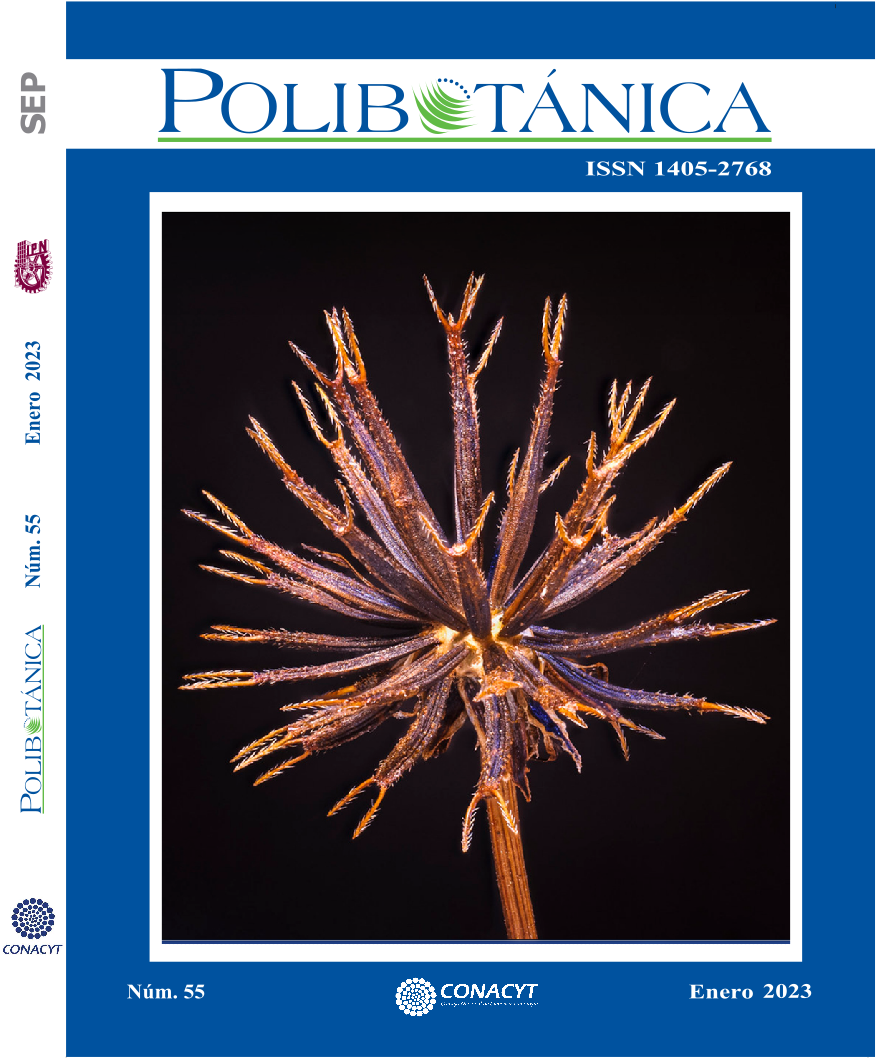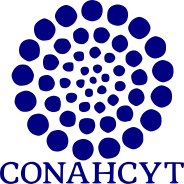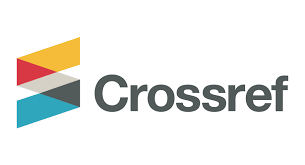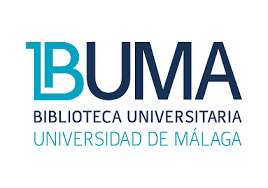Desinfección de foliolos de nogal pecanero adulto Carya illinoinensis (Wangenh.) K. Koch. (Juglandaceae) e inducción de callogénesis in vitro
Resumen
El nogal pecanero es una especie recalcitrante al cultivo in vitro, y comercialmente valorada por la nuez que produce. No existe información sobre el cultivo in vitro de foliolos de pecanero adulto. El objetivo fue determinar cuál es el tamaño y parte de la hoja de nogal pecanero adulto que más favorece la callogénesis in vitro. En julio, las hojas fueron colectadas de la base del árbol, y los foliolos fueron clasificados como: apicales de hoja grande, basales de hoja grande, apicales de hoja chica y basales de hoja chica. Luego, 3 g de foliolos de cada tipo fueron desinfectados mediante una secuencia de inmersiones en alícuotas de 200 mL de: etanol al 70% (V/V) por 2 min; Cloralex 45% (V/V) con 2 gotas/L de Tween 80 por 2 min; cuatro enjuagues con agua por 1 min cada uno; Carbendazim 2 g/L por 20 min; cuatro enjuagues con agua por 1 min cada uno; e inmersión en ácido ascórbico con ácido cítrico (0.15 g/L y 0.25 g/L, respectivamente) durante 12 h. Los explantes fueron cultivados in vitro en medio sólido a concentración completa de sales MS, 1 ppm de ácido 2,4-diclorofenoxiacético, 30 g de sacarosa y 10 g de carbón activado. Se evaluó la incidencia de contaminación, índice de oscurecimiento y callogénesis en los explantes cada 10 días, durante 2 meses. Los explantes de hoja chica sufrieron mayor incidencia de oxidación y contaminación. No se apreció diferencia en la repuesta callogénica de los distintos explantes. Las hojas grandes podrían ser mejores fuentes de explantes por presentar menos oscurecimiento tras el tratamiento de desinfección.
Citas
Aboshama, H. M., El-Sayed, G. A., & Al-Dremly, N. I. (2018). Somatic embryogenesis induction of litchi (Litchi chinensis Sonn.) from leaves of mature trees. JSIR, 7(3): 78-84.
Ahmad, T., & Suzuki, Y. J. (2019). Juglone in oxidative stress and cell signaling. Antioxidants, 8 (91), 1-13.
Al-Khayri, J. M., & Al-Brahrany, A. (2004). Growth, wáter content, and proline accumulation in drought-stressed callus of date palm. Biol. Plant., 48 (1): 105-108.
Ara, T., Karim, R., Karim, M. R., Islam, R., & Hossain, M. (2012). Callus induction and shoot regeneration in strawberry (Fragaria x ananassa Duch.). Int. J. Boisci., 2(10): 93-100.
Ayele, Y. Z., & Tefera, W. (2018). Low cost sterilization and in vitro of vanilla (Vanilla planifolia Andr.). J. Agr. Sci. Food Res., 9 (3): 1-6.
Babaei, N., Abdullah, N. A. P., Saleh, G., & Abdullah, T. L. (2013). Control of contamination and explant browning in Curculigo latifolia in vitro cultures. J. Med. Plants Res. , 7(8): 448-454. doi: 10.5897/JMPR012.859
Behera, K. K., & Sahoo, S. (2009). Rapid in vitro micropropagation of sugarcane (Saccharum officinarum L. cv-Nayana) through callus culture. JNSCI, 7(4): 1-10.
Benson, E. E. (2003). Plant conservation biotechnology. Boca Raton, EUA: CRC Press.
Benson, E. E., (2000). Special symposium: In vitro plant recalcitrance do free radicals have a role in plant tissue culture recalcitrance? In Vitro Cell. Dev. Biol.—Plant, 36(3), 163–170.
Benucci, G. M. N., Bonito, G., Falini, L. B., Bencivenga, M., & Donnini, D. (2012). Mycorrhizal inoculation of pecan seedlings with some marketable truffles. Acta Mycol., 47(2): 179-184.
Borazjani, A., Graves, C. H., & Hedin, P. A. (1985). Occurrence of juglone in various tissues of pecan and related species, J. Physiol. Biochem., 75(12): 1419-1421.
Burns, J. A., & Wetzstein, H. Y. (1995). Development and germination of pecan somatic embryos derived from liquid culture. In Vitro Cell. Dev. Biol., 31: 72-78.
Burns, J. A., & Wetzstein, H. Y. (1997). Development and characterization of embryogenic suspension cultures of pecan. PCTOC, 48: 93-102.
Catapan, E., Luís, M., da Silva, B., Moreno, F. N., & Viana, A. M. (2002). Micropropagation, callus and root culture of Phyllanthus urinaria (Euphorbiaceae). PCTOC, 70: 301-309.
Chaudhury, A., & Qu, R. (2000). Somatic embryogenesis and plant regeneration of turf-type bermudagrass: Effect of 6-benzyladenine in callus induction medium. PCTOC, 60(2): 113-120.
Cosmulescu, S., Trandafir, I., & Nour, V. (2013). Seasonal variation of the main individual phenolics and juglone in walnut (Juglans regia) leaves. Pharm. Biol., 52(5), 575–580.
Coyle, H. M. (2004). Forensic botany: principles and applications to criminal casework. Boca Raton, EUA: CRC Press.
Debnath, S. C. (2009). Characteristics of strawberry plants propagated by in vitro bioreactor culture and ex vitro propagation method. Eng. Life Sci., 9(3): 239-246.
Elhiti M., & Stasolla C. (2011). The use of zygotic embryos as explants for in vitro propagation: an overview. In: T. Thorpe & E. Yeung (Eds.), Plant Embryo Culture: Methods in Molecular Biology (Methods and Protocols), vol. 710 (pp. 229-255). Totowa, USA: Humana Press.
Gazis, R., & Chaverri, P. (2010). Diversity of fungal endophytes in leaves and stems of wild rubber trees (Hevea brasiliensis) in Peru. Fungal Ecol., 3(3): 240-254.
Gond, S. K., Verma, V. C., Kumar, A., Kumar, V., & Kharwar, R. N. (2007). Study of endophytic fungal community from different parts of Aegle marmelos Correae (Rutaceae) from Varanasi (India). World J. Microbiol. Biotechnol., 23: 1371-1375.
Hadacek, F., & Greger, H. (2000).Testing of antifungal natural products: Methodologies, comparability of results and assay choice. Phytochem. Anal., 11: 137-147.
Hammerschmidt, R. (2003). Juglone. In J. R. Plimmer, D. W. Gammon & N. A. Ragsdale (Eds), Encyclopedia of Agrochemicals. Hoboken, USA: John Wiley & Sons.
Hansen, J., Nielsen, B., & Nielsen, S. V. S. (1999). In vitro shoot regeneration of Solanum tuberosum cultivars: Interactions of medium composition and leaf, leaflet, and explant position. Potato Res., 42: 141-151.
Hata, K., & Sone, K. (2008). Isolation of endophytes from leaves of Neolitsea sericea in broadleaf and conifer stands. Mycoscience, 49: 229-232.
Haznedaroglu, M. Z., & Zeybek, U. (2007). HPLC determination of chicoric acid in leaves of Posidonia oceánica. Pharm. Biol., 45(10): 745-748.
Hedin, P. A., Langhans, V. E., & Graves, C. H. (1979). Identification of juglone in pecan as a possible factor of resistance to Fusicladium effusum. J. Agric. Food Chem., 27: 92-94.
Hoque, M. E., & Mansfield, J. W. (2004). Effect of genotype and explant age on callus induction and subsequent plant regeneration from root-derived callus of Indica rice genotypes. Plant Cell, Tissue Organ Cult., 78: 217-223.
Karamian, R., & Ebrahimzadeh, H. (2001). Plantlet regeneration from protoplast-derived embryogenic calli of Crocus cancellatus. Plant Cell, Tissue Organ Cult., 65: 115-121.
Khan, R., Shahzad, S., Choudhary, M. I., Khan, S. A., & Ahmad, A. (2010). Communities of endophytic fungi in medicinal plant Withania somnifera. Pak. J. Bot., 42(2): 1281-1287.
Kumar, S., & Sharma, S. (2005). Somatic embryogenesis and cryopreservation of walnut (Juglans regia L.) and pecan (Carya illinoinensis Koch). Acta Horticulturae: 143-145. doi: 10.17660/ActaHortic.2005.696.24
Litz, R. E. (2005). Biotechnology of fruit and nut crops. New Haven, USA: CABI Publishing.
Liu, Y., Liang, Z., & Zhang, Y. (2010). Induction and in vitro alkaloid yield of calluses and protocorm-like bodies (PLBs) from Pinellia ternate. In Vitro Cellular & Developmental Biology─Plant, 46: 239-245. doi: 10.1007/s11627-009-9268-9
Lu, Z., Huang, M., Dong-Ping, G., Yang, Y. H., Cai, X. N., Qin, P., & She, J. M. (2003). Effect of brassinolide on callus growth and regeneration in Spartina patens (Poaceae). Plant, Cell, Tissue and Organ Culture, 73: 87-89. doi: 10.1023/A:1022665210113
Ma, X. Y., Yi, G. J., Huang, X. L., & Zeng, J. W. (2009). Leaf callus induction and suspensión culture establishment in lychee (Litchi chinensis Sonn.) cv. Huaizhi. Acta Physiologiae Plantarum, 31: 401-405. doi: 10.1007/s11738-008-0223-x
Mathews, H., & Wetzstein, H. Y. (1993). A revised protocol for efficient regeneration of somatic embryos and acclimatization of plantlets in pecan, Carya illinoinensis. Plant Science, 91: 103-108. doi: 10.1023/A:1022665210113
McGranahan, G. H., Leslie, C. A., Dandekar, A. M., Uratsu, S. L., & Yates, I. E. (1993). Transformation of pecan and regeneration of transgenic plants. Plant Cell Reports, 12: 634-638. doi: 10.1007/BF00232814
Medentsev, A. G., Arinbasarova, A. Y., & Akimenko, V. K. (2001). Adaptation of the phytopathogenic fungus Fusarium decemcellulare to oxidative stress. Microbiology, 70: 26-30. doi: 10.1023/A:1004832518783
Mehta, J., Ansari, R., Syedy, M., Khan, S., Sharma, S., Gupta, N., … Vaishnav, K. (2012). An effective method for high frequency multiple shoots regeneration and callus induction of Bacopa monnieri (L.) Pennel.: an important medicinal plant. Asian Journal of Plant Science and Research, 2(5): 620-626. Obtenido de https://go.aws/3cmudnh
Nasircilar, A. G., Turgut, K., & Fiskin, K. (2006). Callus induction and plant regeneration from mature embryos of different wheat genotypes. Pakistan Journal of Botany, 38(2): 637-645. Obtenido de https://bit.ly/3aaV43U
Obeidy, A. A., & Smith, M. A. L. (1993). Organogenesis from mature pecan cotyledons and embryonic axes. Hortsciences, 28(3): 213-215. doi: 10.21273/HORTSCI.28.3.213
Padda, M. S., & Picha, D. H. (2007). Antioxidant activity and phenolic composition in ʻBeauregardʼ sweetpotato are affected by root size and leaf age. Journal of the American Society for Horticultural Science, 132(4): 447-451. doi: 10.21273/JASHS.132.4.447
Payghamzadeh, K., & Kazemitabar, S. K. (2010). The effects of BAP, IBA and genotypes on in vitro germination of immature walnut embryos, International Journal of Plant Production, 4(4): 309-322. Obtenido de https://bit.ly/38bXePs
Phua, Q. Y., Chin, C. K., Asri, Z. R. M., Lam, D. Y. A., Subramaniam, S., & Chew, B. L. (2016). The callugenic effects of 2,4-dichlorophenoxy acetic acid (2,4-D) on leaf explants of sabah snake grass (Clinacanthus nutants). Pakistan Journal of Botany, 48(2): 561-566. Obtenido de https://go.aws/2Tw9Uem
Pooja. (2004). Physiology of angiosperms. New Delhi, India: Discovery Publishing House.
Pretto, F. R., & Santarém, E. R. (2000). Callus formation and plant regeneration from Hypericum perforatum leaves, Plant Cell, Tissue Organ Cult., 62: 107-113.
Renukdas, N. N., Manoharan, M., & Garner, J. O. (2010). In vitro propagation of pecan [Carya illinoinensis (Wangenh) K. Koch]. Plant Biotechnol. J., 27: 211-215.
Rodrigues-Salgado, P., Laércio-Favarin, J., Aparecida-Leandro, R., & Fontão-de Lima Filho, O. (2008). Total phenolic concentrations in coffee tree leaves during fruit development. Sci. Agric., 65(4): 354-359.
Rodriguez, A. P. M., & Wetzstein, H. Y. (1994). The effect of auxin type and concentration on pecan (Carya illinoinensis) somatic embryo morphology and subsequent conversion into plants. Plant Cell Rep., 13: 607-611.
Rodriguez, A. P. M., & Wetzstein, H. Y. (1998). A morphological and histological comparison of the initiation and development of pecan (Carya illinoinensis) somatic embryogenic induced with naphthaleneacetic acid or 2,4-dichlorophenoxyacetic acid. Protoplasma, 204: 71-83.
Salar, R. K., Gahlawat, S. K., Siwach, P., & Duhan, J. S. (2013). Biotechnology prospects and applications. Nueva York, EUA: Springer.
Shibli, R. A., Shatnawi, M., Abu-Ein, & AlJuboory, K. H. (2001). Somatic embryogenesis and plant recovery from callus of ʻNabaliʼ olive (Oleo europea L.). Sci. Hortic., 88: 243-256.
Stella, A., & Braga, M. R. (2002). Callus and cell suspension cultures of Rudgea jasminodes, a tropical woody Rubiaceae. Plant Cell, Tissue Organ Cult. 68: 271-276.
Strugstad, M. P., & Despotovski, S. (2012). A summary of extraction, synthesis, properties, and potential uses of juglone: A literature review. JEM, 13(3): 1-16.
Titov, S., Bhowmik, S. K., Mandal, A., Alam, M. S., & Uddin, S. N. (2006). Control of phenolic compound secretion and effect of growth regulators for organ formation from Musa spp. cv. Kanthali floral bud explants. Am. J. Biochem. Biotechnol., 2(3): 97-104.
Vendrame, W. A., Kochert, G., & Wetzstein, H. Y. (1999). AFLP analysis of variation in pecan somatic embryos. Plant Cell Rep., 18: 853-857.
Wang, K., Herrera-Estrella, A., & Van-Montagu, M. (2004). Transformation of plants and soil microorganisms. Cambridge, England: Cambridge University Press.
Wetzstein, H. Y., Ault, J., & Merkle, S. A. (1989). Further characterization of somatic embryogenesis and plantlet regeneration in pecan (Carya illinoinensis). Plant Sci., 64: 193-201.
Wetzstein, H. Y., Merkle, S. A., & Ault, J. R. (1990). Factors influencing somatic embryogenesis and plantlet regeneration in pecan, Carya illinoinensis. Acta Hortic., 280: 69-73.
Wetzstein, H. Y., Rodriguez A. P. M., Burns J. A., & Magner H. N. (1996). Carya illinoensis (Pecan). In: Y.P.S. Bajaj (Ed.), Trees IV. Biotechnology in Agriculture and Forestry, vol. 35. (50-75). Heidelberg, Alemania: Springer.
Wianowska, D., Garbaczewska, S., Cieniecka-Roslonkiewicz, A., Dawidowicz, A. L., & Jankowska, A. (2016). Comparison of antifungal activity of extracts from different Juglans regia cultivars and juglone. Microb. Pathog., 100: 263-267.
Wilkinson, J. (2005). Nut grower’s guide: The complete handbook for producers and hobbyists. Melbourne, Australia: Land Links.
Xiang, X. G., Zhang, J. B., & Li, R. Q. (2011). Molecular identification of species in Juglandaceae: A tiered method. J. Syst. Evol., 49 (3): 252-260. doi: 10.1111/j.1759-6831.2011.00116
Derechos de autor 2023 POLIBOTÁNICA

Esta obra está bajo licencia internacional Creative Commons Reconocimiento-NoComercial-CompartirIgual 4.0.

Polibotánica por Departamento de Botánica de la Escuela Nacional de Ciencias Biológicas del Instituto Politécnico Nacional se distribuye bajo una Licencia Creative Commons Atribución-NoComercial-CompartirIgual 4.0 Internacional.



















